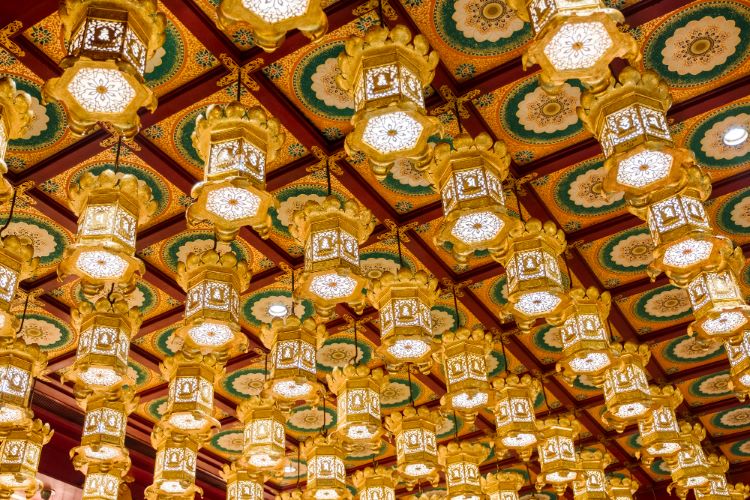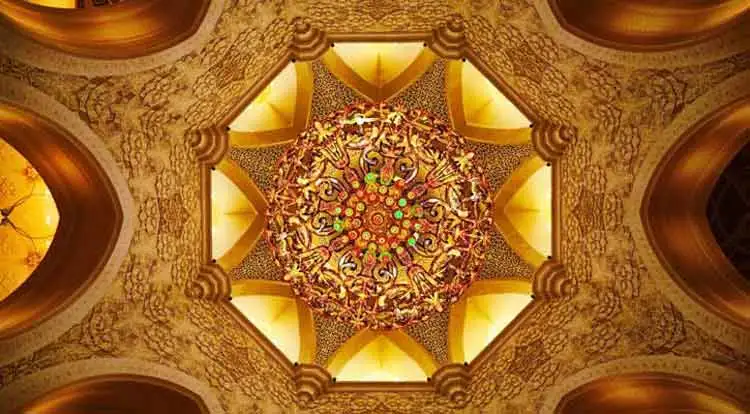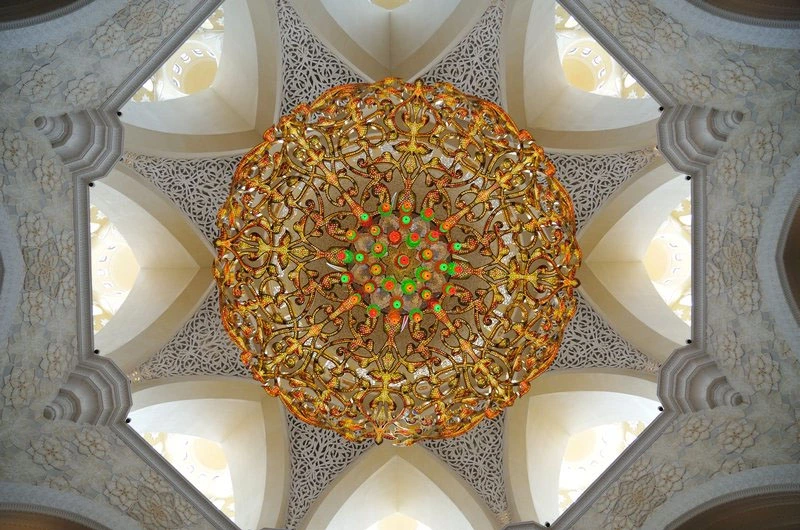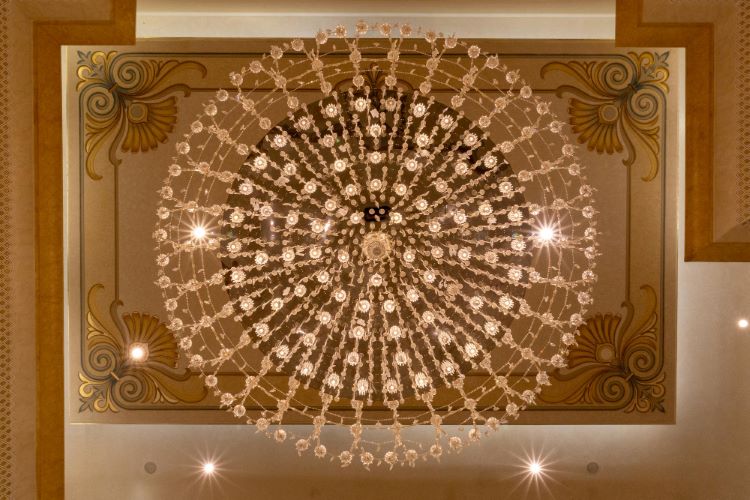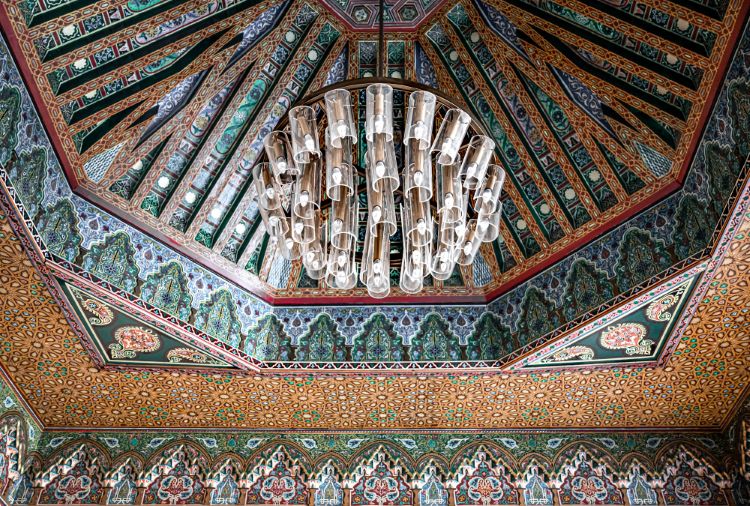Lighting plays a crucial role in Islamic architecture, not just for illumination but also for spiritual symbolism and artistic expression. Among the most intricate and visually stunning elements of mosque interiors are Arabesque patterns in mosque chandeliers. These designs, rooted in sacred geometry, reflect the harmony, balance, and infinite nature of divine creation.
For architects, interior designers, and commercial lighting specialists, understanding Arabesque-inspired chandeliers is essential when designing mosques, luxury residences, or high-end commercial spaces. This article explores the history, significance, and modern innovations of Arabesque patterns in mosque lighting.
What is the arabesque pattern in a mosque?
Arabesque pattern in a mosque are myriads of a distinct art form characterized by a mixture of elaborate geometric forms, stylized plant forms, and at times Arabic script. These designs are methodically arranged to establish a sense of symmetry and balance to reflect both the infinite characteristic and divine order of the universe.
These designs can be found on walls, domes, windows, and especially in the chandeliers, where the arabesque design transforms an ordinary chandelier into a luminous form. For the chandeliers, lighting creates intricate shadows that enhance the prayer hall’s ambiance, generating a vibrancy of spirituality, peace, and respect.
Arabesque designs are a significant part of a visitor’s visual experience since they unite both visual beauty and a symbolic representation of their spiritual beliefs.
Understanding Sacred Geometry in Islamic Art
What is Sacred Geometry?
Sacred geometry is the mathematical foundation behind Islamic art and architecture. It relies on precise geometric patterns and symmetrical compositions to reflect divine harmony. Unlike Western art, which often emphasizes realism, Islamic art uses geometry to represent the infinity of God’s creation.
Common Geometric Shapes in Mosque Design
- Circles & Spheres – Represent divine unity, infinity, and the cosmos.
- Stars & Octagons – Frequently found in mosque domes and chandeliers.
- Interlaced Lines – Symbolize eternity, interconnectedness, and divine order.
Statistics on Sacred Geometry in Islamic Architecture
- 90% of Islamic architectural designs incorporate geometric patterns (Source: Islamic Art Museum).
- 70% of mosque chandeliers use symmetrical, repeating patterns for aesthetic balance (Source: Architecture Digest).
The Role of Arabesque Patterns in Islamic Design
Arabesque patterns are among the most recognizable elements in Islamic decorative arts. These patterns are characterized by:
- Floral Motifs – Stylized vines, leaves, and flowers representing paradise and nature.
- Geometric Patterns – Repetitive, interwoven shapes that create a sense of infinity.
- Calligraphic Inscriptions – Quranic verses seamlessly integrated into designs.
Symbolism of Arabesque Patterns
- Interconnectivity – Represents the interconnectedness of all life under divine order.
- Balance & Harmony – Reflects the perfection of the universe as created by Allah.
- Non-figurative Expression – Adheres to Islamic artistic principles by avoiding human representations.
Where Arabesque Patterns Are Used in Mosques
- Ceilings & Domes – Enhancing architectural grandeur.
- Wall Engravings – Found in marble, wood, or tilework.
- Mosque Chandeliers – Illuminating sacred spaces with intricate light patterns.
How Arabesque Patterns Enhance Mosque Chandeliers
Arabesque designs in chandeliers do more than just beautify—they transform mosque interiors through symbolic lighting and geometric balance.
A. Fusion of Sacred Geometry with Light
- Arabesque metalwork in chandeliers casts intricate shadows, creating a celestial ambiance.
- Circular symmetry in chandeliers mirrors the structure of mosque domes.
- Interwoven floral motifs diffuse light softly, enhancing the meditative atmosphere.
B. Materials & Techniques in Arabesque Chandeliers
- Laser-cut metalwork – Ensures precision in geometric patterns.
- Hand-blown glass & crystal – Diffuses light effectively for a softer glow.
- Gold & brass finishes – Add an element of luxury and tradition.
C. Impact on Mosque Interiors
- Increases Spirituality – Creates a divine atmosphere for worshippers.
- Enhances Aesthetic Appeal – Complements intricate Islamic architecture.
- Promotes Symmetry – Aligns with mathematical precision in mosque design.
Iconic Mosque Chandeliers Featuring Arabesque Patterns
1. Sheikh Zayed Grand Mosque (UAE)
- Materials: Gold-plated metalwork, Swarovski crystals.
- Design Influence: Ottoman and Mamluk geometric patterns.
- Size: One of the world’s largest mosque chandeliers (weighing 12 tons).
2. Alhambra Mosque (Spain)
- Influence: Andalusian Arabesque patterns.
- Lighting Effect: Intricate shadow play on walls and ceilings.
- Symbolism: Blends Islamic and Moorish traditions.
3. Sultan Qaboos Grand Mosque (Oman)
- Design: Laser-etched brass framework with geometric symmetry.
- Lighting: Features 24-carat gold accents for a soft glow.
- Arabesque Patterns: Interwoven octagons and floral arabesques.
4. Hassan II Mosque (Morocco)
- Moroccan-Inspired Arabesque Motifs – Handcrafted Venetian glass chandeliers.
- Calligraphic Detailing – Quranic verses engraved into chandelier frames.
What are the different types of arabesque patterns?
Islamic art includes several distinct types of arabesque patterns, having each its own aesthetic style and symbolic meaning, classified as follows:
- Geometric arabesques: arabesques composed of repeated geometric forms, such as stars, polygons, and interlacing lines. These arabesques highlight symmetry and balance as well as the infinity of creation.
- Floral or Vegetal arabesques: arabesques featuring stylized leaves, vines, and flowers in flowing, interlocking patterns. These floral motifs symbolize growth, life and symmetric harmony with nature.
- Calligraphic arabesques: arabesques containing Arabic script, often coming from verses in the Quran, which come with decorative linear patterns. These ultimately combine the sacred lesson in script and ornamental pattern, contributing to a spiritual atmosphere.
- Mixed or Composite arabesques: arabesques combining Geometric, Floral and Calligraphic aspects into intricate, multi-layered forms or designs. These are often characterized in grand structural features of large mosques or chandelier features.
Each arabesque not only provides decoration, but also stylistic meaning, in that it represents infinity, divine order, and spiritual unity within the sacred setting of an Islamic building.
The Modern Evolution of Arabesque Chandelier Designs
With evolving architectural trends, Arabesque chandeliers are being reimagined to blend tradition with modern lighting technology.
A. LED & Smart Lighting Innovations
- LED-powered chandeliers reduce energy consumption by 60%.
- Dimmable lighting systems allow for adjustable ambiance in mosques.
- Motion-activated chandeliers optimize energy efficiency.
B. Sustainable & Eco-Friendly Materials
- Recycled brass and glass minimize environmental impact.
- Water-based finishing techniques reduce chemical use.
C. Integration with Contemporary Architecture
- Minimalist Arabesque designs complement modern mosque interiors.
- 3D-printed chandeliers allow for lightweight, complex geometric structures.
Conclusion
The presence of Arabesque patterns in mosque chandeliers is more than just an aesthetic choice—it is a deeply rooted expression of sacred geometry and Islamic spirituality. These intricate designs continue to evolve, incorporating modern lighting technologies while preserving traditional artistry.
For architects, interior designers, and lighting specialists, incorporating Arabesque-inspired chandeliers into mosques, commercial spaces, or residential projects offers a blend of elegance, heritage, and innovation.
Further Reading & Lighting Solutions
Looking for Arabesque-inspired chandeliers for your next project? Explore Esco Lights for premium mosque lighting solutions.
FAQ:
Why do mosques have geometric patterns?
Mosques use geometric patterns to create beauty and infinity, a reflection of the divine imperfection of the universe. The potentiality of patterns invites worshipers to think and verbalize, while assuredly, it prohibits any image of a human or an animal making the whole of any visual representation to always appear other than supernatural, reworking harmony and spirituality.
What is the symbolism behind arabesque designs?
Arabesque designs represent infinity, wholeness, and the interconnectedness of creation. Much like more geometric shapes and floral decorations, arabesque designs also arrangement with repeating signifies and creates a contemplative and often sacred space within mosques while reinforcing Islamic design and decoration.

